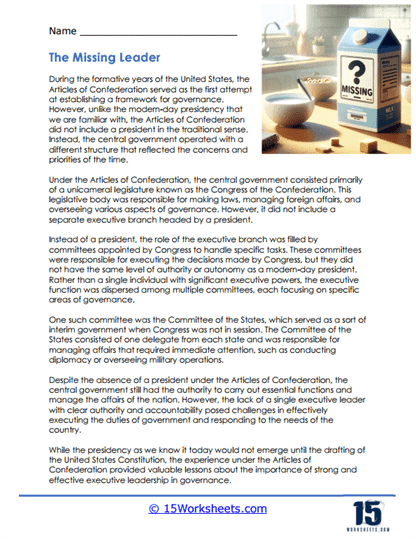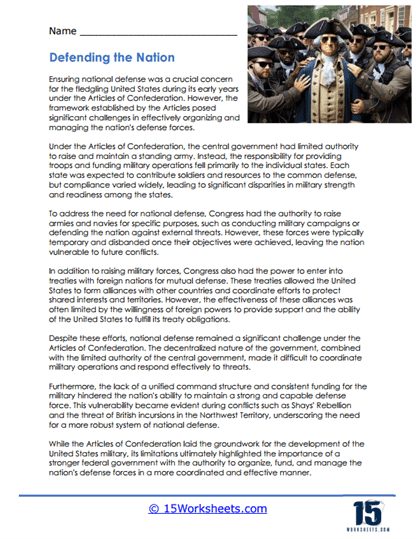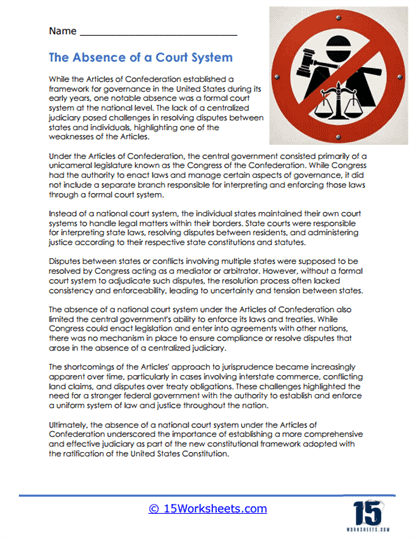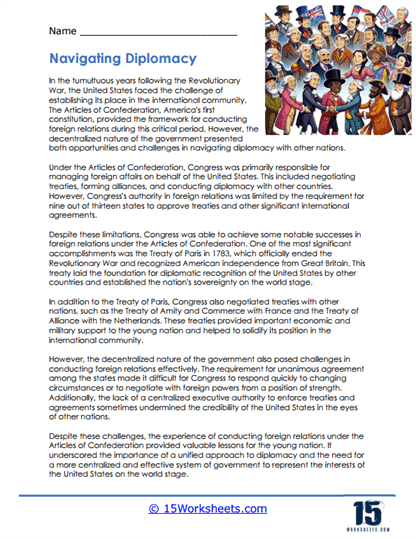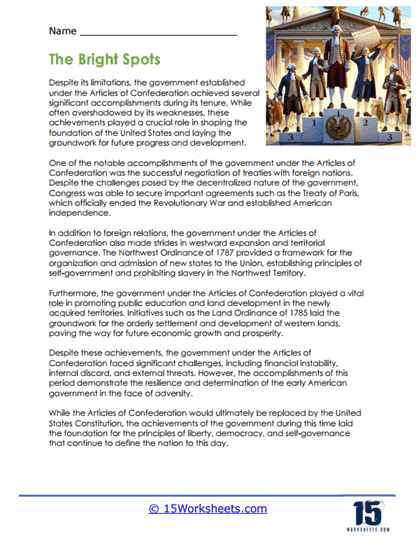Articles of Confederation Worksheets
About These 15 Worksheets
Articles of Confederation worksheets are educational tools designed to enhance students’ understanding of the United States’ first constitution. These worksheets are utilized primarily in educational settings, particularly in courses related to U.S. history, civics, and social studies. They offer a range of exercises that help students engage with the historical, political, and social implications of the Articles of Confederation, which served as the nation’s constitution from 1781 until 1789.
Articles of Confederation worksheets are valuable educational resources that help students engage with and understand a crucial period in American history. Through a variety of exercises, these worksheets enhance historical knowledge, critical thinking, and civic awareness, preparing students for future academic and civic responsibilities.
Types of Exercises On These Worksheets
Reading Comprehension Exercises – These exercises require students to read excerpts or summaries of the Articles of Confederation and answer questions that test their understanding of the content. Questions may focus on the reasons the Articles were drafted, the powers granted to the national government, and the limitations that led to their eventual replacement by the U.S. Constitution.
Fill-in-the-Blanks – This type of exercise helps students focus on key vocabulary and concepts associated with the Articles of Confederation. By filling in missing words or phrases in prepared sentences, students reinforce their knowledge of specific details such as the roles of different branches of government under the Articles, the concept of state sovereignty, and other pertinent terminology.
Multiple Choice Questions – These questions provide students with several possible answers to questions about the Articles of Confederation. They assess students’ knowledge and understanding of the document’s structure, its historical context, and its impact on American history.
Matching Exercises -Students match terms with their definitions or important dates with events that highlight significant moments in the history of the Articles of Confederation. This exercise type encourages memorization and helps students make connections between different historical facts.
Timeline Activities – These activities require students to create or complete timelines related to the development, implementation, and eventual dissolution of the Articles of Confederation. Timelines help students visualize the chronological sequence of events and understand the broader historical context.
The Benefits of These Worksheets
Practicing with Articles of Confederation worksheets offers several educational benefits:
Enhanced Understanding of Historical Context – These worksheets help students grasp the complexities of the early American political landscape. By engaging with the content of the Articles, students better understand the foundational ideas that shaped the nation.
Critical Thinking and Analysis – Exercises like essay writing and discussions prompt students to think critically about the Articles of Confederation’s impact on American history. This analysis fosters a deeper understanding of how and why the U.S. Constitution was created.
Improved Information Retention – The variety of exercises available on these worksheets caters to different learning styles, helping students retain information more effectively. Activities like matching, fill-in-the-blanks, and crossword puzzles reinforce knowledge through repetition and engagement.
Development of Research Skills – Some worksheets may require students to research additional information about the Articles of Confederation, thus improving their research skills and encouraging a proactive approach to learning.
Preparation for Higher Education and Civic Engagement – Understanding the Articles of Confederation prepares students not only for advanced studies in history and government but also for active and informed civic participation. Knowledge of the country’s foundational documents is crucial for understanding contemporary political debates and responsibilities.
What Were the Articles of Confederation?
The Articles of Confederation, formally named the Articles of Confederation and Perpetual Union, were the first governing document of the United States of America. They served as the official constitution from March 1, 1781, until they were replaced by the U.S. Constitution on March 4, 1789. The Articles were drafted during the early part of the American Revolution by a committee appointed by the Second Continental Congress, including notable figures such as John Dickinson, who initially drafted the plan in 1776. However, it wasn’t until November 15, 1777, that the Articles were approved by Congress, and they took several years to be ratified by all thirteen states.
Key Features of the Articles of Confederation
The Articles established a confederation-a group of states united for a common purpose—but allowed these states to retain their sovereignty, freedom, and independence. Under the Articles, the states were joined together for common defense, securities of liberties, and mutual and general welfare. This union was essentially a loose federation where the national government had limited powers.
Structure of Government
The national government under the Articles of Confederation consisted of a single body, the Congress of the Confederation, which contained delegates appointed by the state legislatures. Each state had one vote in Congress, regardless of its size or population, emphasizing the principle of equality among the states.
Powers of Congress
Congress held several powers essential for governance, though these were significantly restricted compared to the later Constitution. These powers included:
- Making war and peace.
- Conducting foreign affairs.
- Negotiating with Native American tribes.
- Establishing a postal system.
- Coining money.
Managing Western territories and regulating their admission as states.
However, Congress lacked the authority to levy taxes, regulate interstate and foreign commerce, and enforce its laws directly on the states or their citizens. Instead, it had to rely on financial contributions from the states, which were voluntary and often insufficient.
Limitations
The Articles of Confederation had several notable limitations:
- No executive branch to enforce laws or oversee the administration of government.
- No national judiciary to interpret laws or settle disputes between states.
- Amendments to the Articles required the unanimous consent of all thirteen states, making changes to the system exceedingly difficult.
Challenges and Downfalls
The weaknesses of the Articles became apparent shortly after their implementation. The lack of central authority meant that the government was unable to maintain stability or effectively manage the country’s finances, defense, or international relations. Economic turmoil, such as rampant inflation and trade disputes between states, was common. Furthermore, the inability to levy taxes led to significant debt, and the national government struggled to pay the Continental Army or fulfill other financial obligations.
These issues culminated in events like Shays’ Rebellion (1786-1787), an armed uprising in Massachusetts that highlighted the national government’s weakness. Such incidents underscored the need for a more robust federal government, leading to the Constitutional Convention in 1787, where the U.S. Constitution was drafted as a replacement for the Articles.
Historical Significance
Despite their shortcomings, the Articles of Confederation played a crucial role in the early governance of the United States and the ideological development of the country. They reflected the colonies’ fierce protection of their own sovereignty and their fear of centralized power, a legacy stemming from their experiences under British rule. The Articles also laid the groundwork for certain concepts that were carried over into the Constitution, such as the importance of state sovereignty and federalism.










